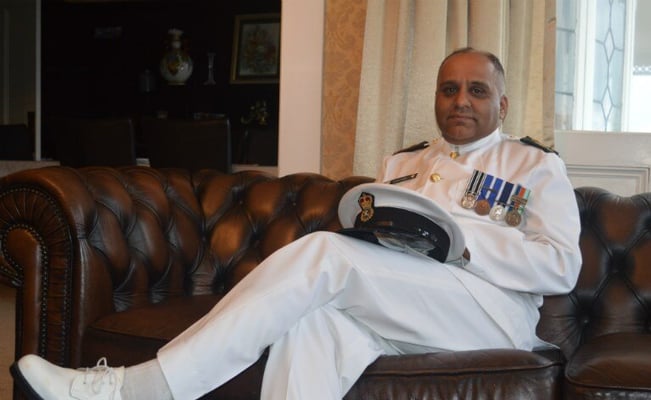The Indian connection in the Royal New Zealand Navy

In 2016, the Royal New Zealand Navy (RNZN) celebrated its 75th anniversary through a series of events over the year, culminating in an International Fleet Review in mid-November when vessels from international Navies visited Auckland for five days. RNZN was keen to project that event as an opportunity to celebrate "the story of the Navy, our history, our values and how we serve New Zealand."
Following this cue, Indian Weekender was keen to find and celebrate stories about the contribution of Kiwi-Indians or New Zealanders of Indian-descent to the Navy and New Zealand.
In this regard, it is important to note that although Indian immigrants arrived in New Zealand in the late 18th century, it was not easy to find many people of Indian-origin serving in the Royal Navy.
This was when the earliest Indian settlers in New Zealand largely included Lascars (Indian seamen) and Sepoys (Indian soldiers) from the East Indian Company ships, who stopped in New Zealand on their way back to Australia from India.
The reasons can be easily found in the history of Royal New Zealand Navy, the shaping of New Zealand nation itself as separate and distinct from the Great Britain, and the evolution of immigration policies that have shaped our nation.
Nevertheless, our search for any Indian-origin serving naval personnel eventually led us to Harrai Chan Sund alias Peter Sund who is now officially recorded as the first Indian-origin personnel to serve in the RNZN.
Mr Sund has not only completed his full term in the RNZN but has also served as a reservist for almost a decade. He was also involved in the International Naval Fleet Review, from where our interest on the issue originally began.
Since the Navy plays such an important part in building the nation, it was tempting to find and recognise the contribution of people of Indian-descent in this endeavour.
To our astonishment, Mr Sund had joined the RNZN in 1985, a period when the total population of people identifying their ethnicity, as Indian in New Zealand was roughly around 11,600.
Moreover, by that time, RNZN itself had a history of four decades of independent existence as a state institution separate from the Royal Navy (British Navy).
RNZN was officially established on October 1, 1941, and had a long gestation period as an institution of the state during which it gradually evolved away from the initial British influences.
The fact that an Indian-origin immigrant became a serving member of the RNZN within four decades of its independent existence deserves some merit about the New Zealand nation-building and the overall role of new immigrants in the nation-building.
We bring you excerpts of the interview with Mr Sund and his wife Paramjeet Sund.
IWK: Can you tell us a little more about yourself and the feeling of being the first person of Indian-origin to serve in the RNZN?
Peter: I joined RNZN in 1985 in the engineering branch and later in 1995 changed over to Naval Police trade. I retired from the regular service in 2006 as Warrant Officer, Head of Naval Police trade. Since then, I have been a reservist in the Navy and was also associated with the latest International Naval Fleet Review.
IWK: Please tell our readers about your history in New Zealand. How long have you been in this country?
Peter: I am a fourth generation Kiwi-Indian. My great grandfather Libu Ram Sund arrived in New Zealand in 1916. We celebrated 100 years in New Zealand last year. My grandfather Singu Ram Sund then came to New Zealand at the age of 14. My father was born in New Zealand in Napier, and I was obviously born in New Zealand as well. My boys are fifth generation Kiwi-Indians.
IWK: Talking to you and your family, especially your young boys, it seems that you have maintained a connection with your culture and roots back in India very well. Can you tell how you have managed that?
Paramjeet: We make it a point that our boys and the coming generations remain well connected with our culture and roots. Therefore, we prefer to speak at home in our native language (Punjabi) and take our boys regularly to Gurudwaras and often back to our ancestral place in India. We want them to cherish our cultural heritage. Recently, we went to India for six weeks and arrived back in New Zealand just last week. We took our boys to different places around India, apart from our native place in Punjab, such as Udaipur, Delhi, Chandigarh, and Agra, just for them to have a feel of Indian culture.
IWK: How was their experience?
Paramjeet: They just loved it. In fact, we were surprised that among all the places they visited, they felt most attached to our ancestral village in Punjab.
IWK: Coming back to your career in Navy, military career may not be a usual career choice for the Indian immigrants in New Zealand. What prompted you to choose Navy as a career?
Peter: I was looking for a career that was different from other mainstream jobs, which gives me some travelling opportunity and above all, offers a sense of fulfilment. I would say that at the end I was able to achieve all of those in my naval career.
IWK: When you started your service in 1985, at that time there were around 11,600 people of Indian-origin in New Zealand. It must have been an exclusive feeling to be serving in the Navy then. Can you tell our readers little bit more about that feeling?
Peter: Yes, it was an exclusive feeling. I do recall that when I joined the service, obviously, there were no Indians in the Navy. It was a novelty to have Indians in the Navy, and it was very enjoyable.
IWK: Do you recall any day-to-day experiences related to your ethnic identity of being of Indian-origin?
Peter: I can recall an experience during a church service right at the start of training where our group was being commanded to split into two denominations—Anglican and Catholics. At that time, they would say "...and will have one Sikh stand to one side (laughs)," knowing that they did not have Gurudwaras for the Sikhs to visit at that time.
That was an opportunity for me to stay back in barracks and work on my uniforms and kits.
IWK: Can you share some moments and high points from your naval career that you cherish most?
Peter: In 1988, I was a part of the commissioning crew of HMNZS Endeavour, which is a New Zealand refuelling tanker, and that tanker was commissioned in South Korea. We were part of that commissioning crew that brought back the ship to New Zealand via Singapore and Perth. I remained on that ship for about three years after commissioning. In addition to that, I was a part of the second rotation crew on the HMNZS Te Mana where I remained posted for two-and-a-half years. It is a part of my career, which I thoroughly enjoyed. In 1995, when I changed over to Naval Police trade, I had some opportunities to attend several events involving my trade, which I also enjoyed. In 2003, I served in Bosnia under NATO and remained posted there for about nine months.
IWK: Have you ever been a part of any major sea operation in New Zealand or overseas or any other overseas deployment.
Peter: Yes, I have and on a number of occasions. I do recall that in the late 1980s and early 1990s when I was on HMNZS Endeavour, we were called upon to assist in relief and rescue operations in the South Pacific. We have assisted in Bougainville Peace Talks and evacuation assistance in Solomon Islands. Therefore, there have been many occasions.
IWK: Do you have any message for the youngsters in our Kiwi-Indian community?
Peter: For anyone considering a career, it's [navy] definitely a fantastic opportunity that one should consider. There is lots of comradeship; the opportunities are immense and it’s going to be a career that would be very fulfilling. It is a career that I wholeheartedly encourage people to consider seriously.
In 2016, the Royal New Zealand Navy (RNZN) celebrated its 75th anniversary through a series of events over the year, culminating in an International Fleet Review in mid-November when vessels from international Navies visited Auckland for five days. RNZN was keen to project that event as an...
In 2016, the Royal New Zealand Navy (RNZN) celebrated its 75th anniversary through a series of events over the year, culminating in an International Fleet Review in mid-November when vessels from international Navies visited Auckland for five days. RNZN was keen to project that event as an opportunity to celebrate "the story of the Navy, our history, our values and how we serve New Zealand."
Following this cue, Indian Weekender was keen to find and celebrate stories about the contribution of Kiwi-Indians or New Zealanders of Indian-descent to the Navy and New Zealand.
In this regard, it is important to note that although Indian immigrants arrived in New Zealand in the late 18th century, it was not easy to find many people of Indian-origin serving in the Royal Navy.
This was when the earliest Indian settlers in New Zealand largely included Lascars (Indian seamen) and Sepoys (Indian soldiers) from the East Indian Company ships, who stopped in New Zealand on their way back to Australia from India.
The reasons can be easily found in the history of Royal New Zealand Navy, the shaping of New Zealand nation itself as separate and distinct from the Great Britain, and the evolution of immigration policies that have shaped our nation.
Nevertheless, our search for any Indian-origin serving naval personnel eventually led us to Harrai Chan Sund alias Peter Sund who is now officially recorded as the first Indian-origin personnel to serve in the RNZN.
Mr Sund has not only completed his full term in the RNZN but has also served as a reservist for almost a decade. He was also involved in the International Naval Fleet Review, from where our interest on the issue originally began.
Since the Navy plays such an important part in building the nation, it was tempting to find and recognise the contribution of people of Indian-descent in this endeavour.
To our astonishment, Mr Sund had joined the RNZN in 1985, a period when the total population of people identifying their ethnicity, as Indian in New Zealand was roughly around 11,600.
Moreover, by that time, RNZN itself had a history of four decades of independent existence as a state institution separate from the Royal Navy (British Navy).
RNZN was officially established on October 1, 1941, and had a long gestation period as an institution of the state during which it gradually evolved away from the initial British influences.
The fact that an Indian-origin immigrant became a serving member of the RNZN within four decades of its independent existence deserves some merit about the New Zealand nation-building and the overall role of new immigrants in the nation-building.
We bring you excerpts of the interview with Mr Sund and his wife Paramjeet Sund.
IWK: Can you tell us a little more about yourself and the feeling of being the first person of Indian-origin to serve in the RNZN?
Peter: I joined RNZN in 1985 in the engineering branch and later in 1995 changed over to Naval Police trade. I retired from the regular service in 2006 as Warrant Officer, Head of Naval Police trade. Since then, I have been a reservist in the Navy and was also associated with the latest International Naval Fleet Review.
IWK: Please tell our readers about your history in New Zealand. How long have you been in this country?
Peter: I am a fourth generation Kiwi-Indian. My great grandfather Libu Ram Sund arrived in New Zealand in 1916. We celebrated 100 years in New Zealand last year. My grandfather Singu Ram Sund then came to New Zealand at the age of 14. My father was born in New Zealand in Napier, and I was obviously born in New Zealand as well. My boys are fifth generation Kiwi-Indians.
IWK: Talking to you and your family, especially your young boys, it seems that you have maintained a connection with your culture and roots back in India very well. Can you tell how you have managed that?
Paramjeet: We make it a point that our boys and the coming generations remain well connected with our culture and roots. Therefore, we prefer to speak at home in our native language (Punjabi) and take our boys regularly to Gurudwaras and often back to our ancestral place in India. We want them to cherish our cultural heritage. Recently, we went to India for six weeks and arrived back in New Zealand just last week. We took our boys to different places around India, apart from our native place in Punjab, such as Udaipur, Delhi, Chandigarh, and Agra, just for them to have a feel of Indian culture.
IWK: How was their experience?
Paramjeet: They just loved it. In fact, we were surprised that among all the places they visited, they felt most attached to our ancestral village in Punjab.
IWK: Coming back to your career in Navy, military career may not be a usual career choice for the Indian immigrants in New Zealand. What prompted you to choose Navy as a career?
Peter: I was looking for a career that was different from other mainstream jobs, which gives me some travelling opportunity and above all, offers a sense of fulfilment. I would say that at the end I was able to achieve all of those in my naval career.
IWK: When you started your service in 1985, at that time there were around 11,600 people of Indian-origin in New Zealand. It must have been an exclusive feeling to be serving in the Navy then. Can you tell our readers little bit more about that feeling?
Peter: Yes, it was an exclusive feeling. I do recall that when I joined the service, obviously, there were no Indians in the Navy. It was a novelty to have Indians in the Navy, and it was very enjoyable.
IWK: Do you recall any day-to-day experiences related to your ethnic identity of being of Indian-origin?
Peter: I can recall an experience during a church service right at the start of training where our group was being commanded to split into two denominations—Anglican and Catholics. At that time, they would say "...and will have one Sikh stand to one side (laughs)," knowing that they did not have Gurudwaras for the Sikhs to visit at that time.
That was an opportunity for me to stay back in barracks and work on my uniforms and kits.
IWK: Can you share some moments and high points from your naval career that you cherish most?
Peter: In 1988, I was a part of the commissioning crew of HMNZS Endeavour, which is a New Zealand refuelling tanker, and that tanker was commissioned in South Korea. We were part of that commissioning crew that brought back the ship to New Zealand via Singapore and Perth. I remained on that ship for about three years after commissioning. In addition to that, I was a part of the second rotation crew on the HMNZS Te Mana where I remained posted for two-and-a-half years. It is a part of my career, which I thoroughly enjoyed. In 1995, when I changed over to Naval Police trade, I had some opportunities to attend several events involving my trade, which I also enjoyed. In 2003, I served in Bosnia under NATO and remained posted there for about nine months.
IWK: Have you ever been a part of any major sea operation in New Zealand or overseas or any other overseas deployment.
Peter: Yes, I have and on a number of occasions. I do recall that in the late 1980s and early 1990s when I was on HMNZS Endeavour, we were called upon to assist in relief and rescue operations in the South Pacific. We have assisted in Bougainville Peace Talks and evacuation assistance in Solomon Islands. Therefore, there have been many occasions.
IWK: Do you have any message for the youngsters in our Kiwi-Indian community?
Peter: For anyone considering a career, it's [navy] definitely a fantastic opportunity that one should consider. There is lots of comradeship; the opportunities are immense and it’s going to be a career that would be very fulfilling. It is a career that I wholeheartedly encourage people to consider seriously.









Leave a Comment